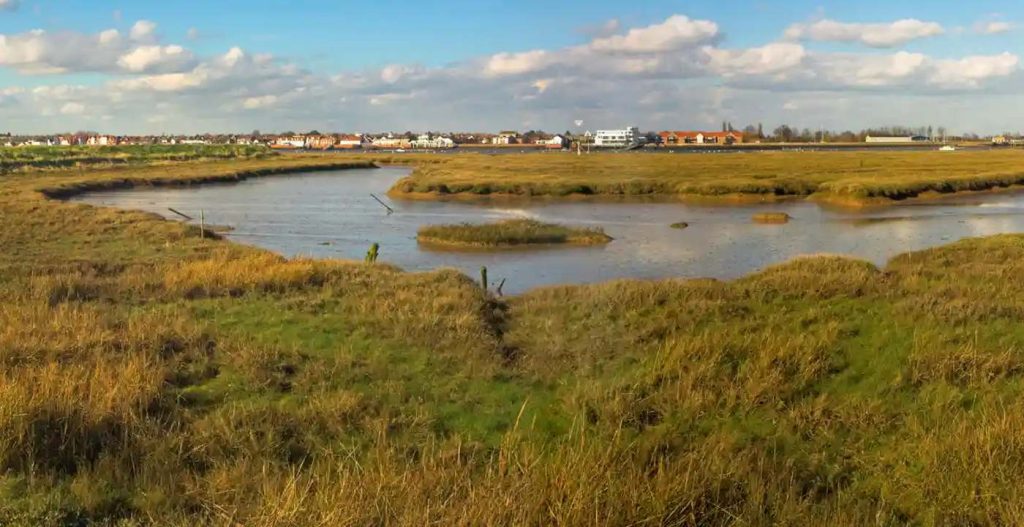Millions of Tons of Earth Dug for New London Subway Line Became a New Bird Sanctuary

Multi-billion dollar civic engineering projects tend not to be good news for wildlife, but upon the completion of a new English underground railway line, the upturned earth was used to rebuild a coastal habitat for birds in Essex.
The new bird sanctuary instantly became one of the richest in Britain’s coastline for avocets, spoonbills, black-tailed godwits, and other wading birds.
The Elizabeth Crossrail is a high-speed line that runs from Reading to the west of London, through the capital, to Shenfield near the east coast. During the $24 million (£19 million) project, seven million metric tons of soil was dug up to make thirteen underground railway tunnels, half of which were transported by boat to the eastern shore of the country.
The earth was taken to a place called Wallasea Island, once just a tiny peninsula of the wild Essex coastline, consisting of salt marshes, coastal lagoons, muddy flatlands, and other features, but several times during the Medieval period and after it was drained to make sheep pasture or farmland.
Farming often is not as profitable now as it was then, and as the defensive seawall was in need of repairs, the farmer that used to own the land sold it to the Royal Society for the Protection of Birds.
“Massive amounts of soil were dug up from below the streets of London during tunneling needed to create the Elizabeth line,” said Rachel Fancy, site manager of RSPB Wallasea Island. “That material was given to the RSPB, allowing us to create our Jubilee Marsh, the cornerstone of our new reserve.”
Jubilee is the appropriate name in this case. Bird-friendly journalists from the Guardian, reporting on the state of Wallasea Island, now note the diversity of species and the rich numbers.
Hen and marsh harriers have appeared in winter while wigeon, teal, plover, yellow wagtail, lapwings, blackbirds, oystercatchers, and skylarks were all recorded in what reporters called a “nature lover’s paradise.”
It took 1,500 trips by canal to bring the dirt to Wallasea. Once there it was transported via conveyor belt to a dump, where tipper trucks slowly deposited it along the shoreline to create a steady sloping terrain up from the sea, protecting it from rising levels.
After the manicuring and landscaping was finished, the seawall was strategically breached in three separate places at low tide, which, once it rose again, gently partitioned the landscape into the various landscape features seen today, as opposed to turning it into a big muddy lake if the wall had been breached all at once at high tide.
In its first year, Wallasea Nature Reserve hosted 150 breeding pairs of avocets, which is endangered-in-Britain, instantly making it one of the bird’s strongholds.
“We are really proud that Jubilee Marsh is helping to combat the threats from climate change and coastal flooding,” Mark Wild, Crossrail’s chief executive, told the Guardian.
The good news here is that with proper planning human expansion need not come at the expense of the earth. Today’s JohnKu talks about stewardship. I hope you all have a super weekend.
Our Earth by John W. Howell © 2022
This is all we have,
Humans need to work smarter . . .
To preserve our life.





















What a great story, John. A little extra money spent for some very good reasons. Great poem.
LikeLiked by 2 people
I think it shows development with sense is possible. Thanks, Dan.
LikeLiked by 1 person
This is a great story. Thanks for sharing, John!
LikeLiked by 2 people
Thanks, Jill.
LikeLike
What a terrific way to create a win/win! Thank you for sharing, John.
LikeLiked by 1 person
Thanks for letting me know you liked it, Annette.
LikeLiked by 1 person
What a wonderful story! Thank you for bringing us some good news today, John.
LikeLiked by 1 person
It always feels good to find these stories. Thanks, Joan
LikeLiked by 1 person
That’s quite a lot of work, but so worth it. Even the name is lovely. Thanks for my Friday smile.
LikeLiked by 1 person
Always glad to deliver a smile. 😊
LikeLiked by 1 person
Thank you for sharing this wonderful story, John. It’s wonderful when projects are thought out thoroughly!
Happy Friday to you.
LikeLiked by 1 person
It is wonderful, Dale. Happy Friday to you.
LikeLiked by 1 person
Thank you, kind sir
LikeLiked by 1 person
🤗
LikeLiked by 1 person
They have every right to be proud! This is a remarkable feat!
LikeLiked by 1 person
It is. I can’t imagine the work involved.
LikeLiked by 1 person
The same thing is happening here, where spoil from the dredging and widening of the Houston ship channel is being used to create wildlife-friendly ‘islands’ in the bay. Creativity is possible!
LikeLiked by 1 person
It is so good to see too. Thanks, Linda.
LikeLiked by 1 person
It’s wonderful how a bit of extra attention can accomplish so much more.
LikeLiked by 1 person
I agree. So well thought out.
LikeLiked by 1 person
That’s a smart repurposing. Should happen more often.
LikeLiked by 1 person
It should. One would hope it will. Thanks, Charles.
LikeLike
That is good news. It’s refreshing to see humans doing something that makes sense. Your poem says it all. Thanks for sharing, John. 🙂
LikeLiked by 1 person
It is refreshing since it so seldom happens. Thanks, Tim.
LikeLiked by 1 person
Reblogged this on T. W. Dittmer and commented:
This story from author John Howell’s blog is such good news to me that I wanted to share it.
LikeLiked by 1 person
Thank you for sharing the post, Tim.
LikeLiked by 1 person
Fri-yays are always the highlight of the week. Thank you for the reminder of what is possible if we work together. Beautiful, John. 💗
LikeLiked by 1 person
Thank you, Gwen. I think if folks think things out miracles can happen. 😁
LikeLike
Wow, this project is so heartening! There just might be hope for us, after all.
LikeLiked by 1 person
That’s what I was thinking, Liz.
LikeLiked by 1 person
I can’t imagine how much dirt that is, but look at all the good it did.
LikeLiked by 1 person
I know right? I can’t imagine moving it all.
LikeLiked by 1 person
John, thanks for sharing this terrific story. It’s good to give back to mother earth.
LikeLiked by 1 person
This is a great story. Restores my faith in what I usually consider dumb a—s who do construction without a thought for the environment.
LikeLiked by 1 person
I’m with you, Noelle. Loved your description.
LikeLiked by 1 person
A wonderful story. Thanks so much for sharing. Your Haiku is perfect too.
LikeLiked by 1 person
Thank you, Darlene
LikeLiked by 1 person
This is one instance where progress has a happy ending. Thanks for sharing, John!
LikeLiked by 1 person
Thant is for sure. Thanks Jan
LikeLike
Awesome story, John, and proof that solutions can be found that don’t inconvenience one species for another! Thanks for sharing this good news!
LikeLiked by 1 person
That is the lesson of this story for sure. Thanks, Debbie
LikeLiked by 1 person
Wonderful news indeed, dear John. Let’s hope there will be more of them around. 🙂
LikeLiked by 1 person
That is a great hope, Maria.
LikeLike
What a jubilee it is, when we worth WITH the earth instead of against it.
Another classic, Boss.
LikeLiked by 1 person
Thank you, Marc
LikeLiked by 1 person
Thanks for the wonderful story and good news, John, along with your wonderful Ku. You’re right about humans.
LikeLiked by 1 person
Thanks. Lauren
LikeLiked by 1 person
You’re welcome, John. Enjoy your weekend.
LikeLike
Enjoy yours as well, Lauren
LikeLiked by 1 person
A case of “if you build it, they will come.” . I love the symbiosis of these projects. Good for everyone. Great story, John.
LikeLiked by 1 person
So true, Diana
LikeLiked by 1 person
Wonderful! I love to hear about things like this, John. Thanks so much for sharing this. A lovely positive note to end the week. Hugs on the wing.
LikeLiked by 1 person
Yes it is Teagan. Thank you for the visit and comment. 😁
LikeLike
You sure this happened in England? We did some adulting? Well who knew? Someone got the money wrong, mind as it cost billions not millions but I’m pro the line so all round Yay!
LikeLiked by 1 person
Yes I wondered about that but since I lifted the article I decided to leave the money part alone. Yes that was you guys doing a good thing. Maes us Yanks almost sorry we threw you out. (Almost)
LikeLiked by 1 person
You’ve done okay since you walked out in a huff…
LikeLiked by 1 person
No you guys walked out in a huff. We are still here. Just shows to go ya perspective is everything.
LikeLike
This is a very happy outcome for the birds and humans who can now enjoy nature and transportation.
LikeLiked by 1 person
So true, Deborah. Thank you
LikeLiked by 1 person
This is good news!We need more of this sharing and refurbishing with and of mother nature.
Another wise, wise, wise, JohnKu.
Thank you!
LikeLiked by 1 person
Thank you Resa. You are right we need to do more.
LikeLiked by 1 person
We can work smarter, this proves it. All we need is the will. It was wonderful to see that some have.
LikeLiked by 1 person
Yes. Good to see
LikeLiked by 1 person
Talk about a win-win! That’s wonderful. Thanks for sharing that, John. 🙂
LikeLiked by 1 person
Wonderful!
LikeLiked by 1 person